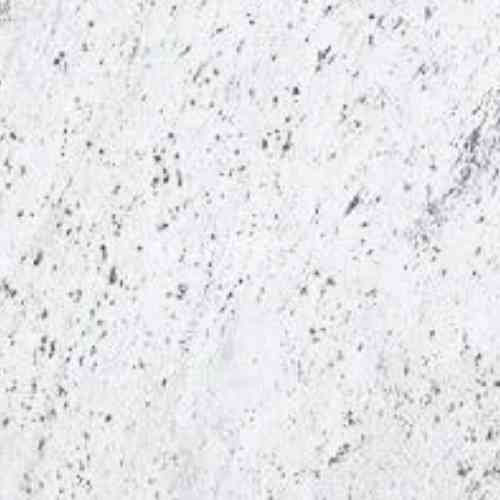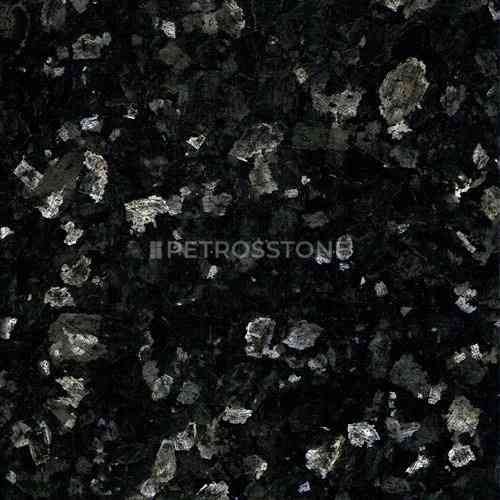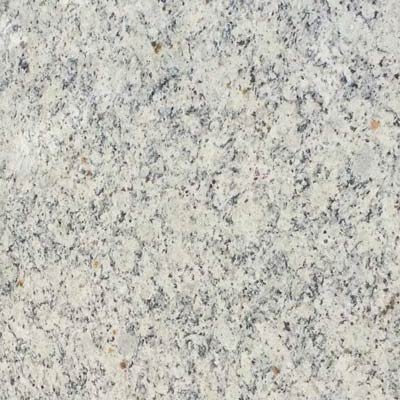
Quartz and sintered stone are two of the most popular materials for your home’s countertops, flooring, or other surfaces. Each material has unique qualities, making the decision challenging.
This guide dives deep into the pros, cons, differences, and practical considerations to help you make an informed choice between quartz and sintered stone.
What are Quartz Slabs?
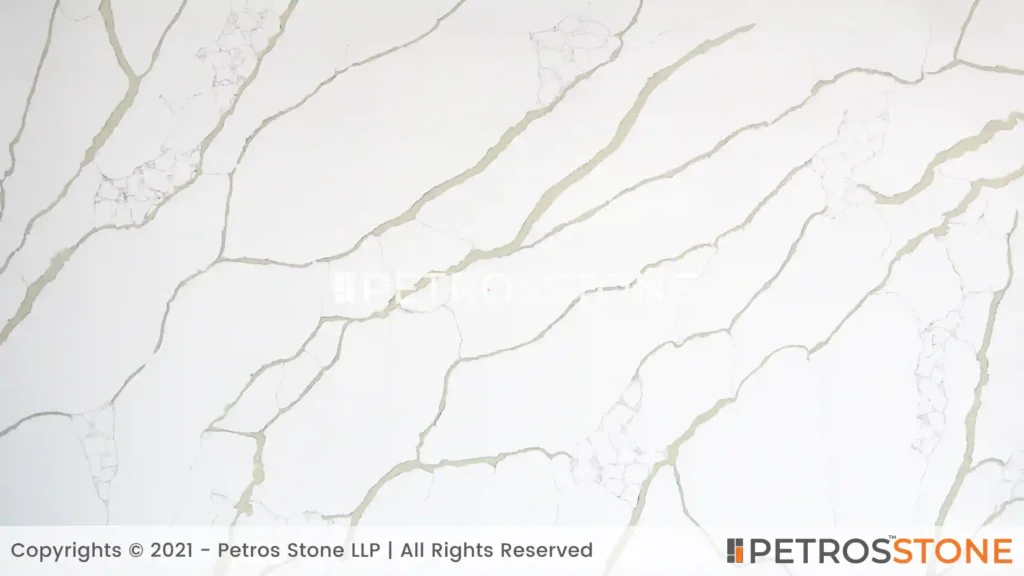
Quartz is an engineered stone that combines natural quartz crystals — one of the hardest minerals on Earth — with resins, polymers, and pigments. This unique blend results in a material that is not only durable but also non-porous.
What makes quartz particularly popular is that it merges the strength of natural stone with the design flexibility of man-made materials. The result? A non-porous, resilient surface that resists stains, scratches, and bacteria — perfect for both residential and commercial spaces.
How is Quartz Made?
- The creation of quartz slabs involves an intricate, high-tech manufacturing process. It starts with crushing raw quartz into a fine powder or small granules. These particles are then mixed with resins (for bonding), polymers (for flexibility), and pigments (for colour and design).
- The mixture is poured into melds and compressed under extreme pressure using a machine called a vibro-compressor. Simultaneously, heat is applied to cure and harden the slab. This process, known as vacuum vibro compression, ensures the slab is dense, non-porous, and highly durable.
- After curing, the slabs are polished to achieve a smooth, glossy finish—matte and textured finishes are also available. The final product mimics the look of natural stone, like granite or marble, but with added resilience and consistency in colour and pattern.
What is Sintered Stone?
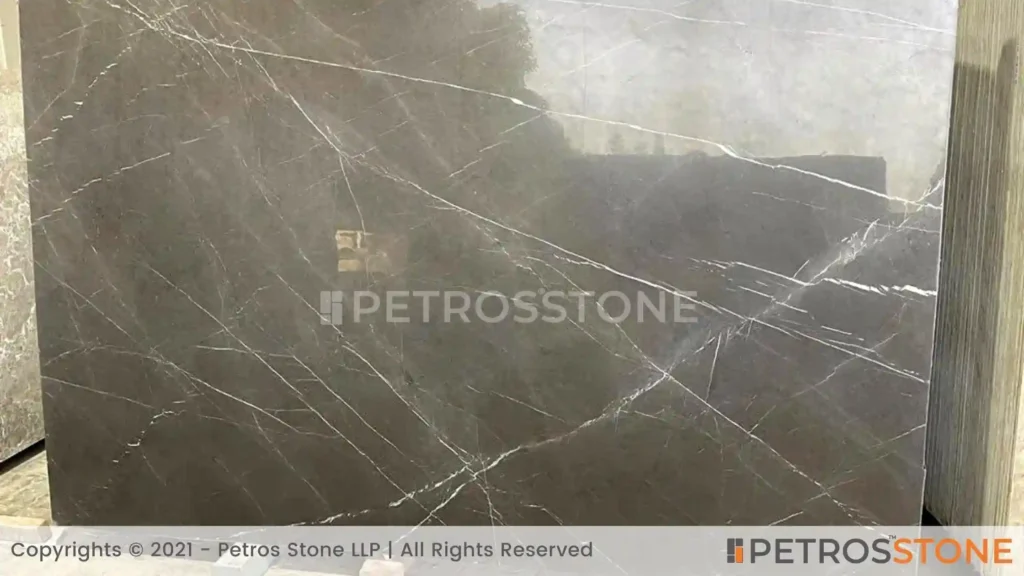
Sintered stone is crafted through an advanced process called sintering, where natural minerals — like quartz, feldspar, silica, and clays — are exposed to extreme heat (over 1200°C) and intense pressure. This mimics the way natural stone forms over thousands of years — but in just a few hours.
The result? A surface that’s ultra-dense, incredibly durable, and visually stunning — all without the need for resins or binders commonly found in engineered stone like quartz.
Differences Between Quartz and Sintered Stone
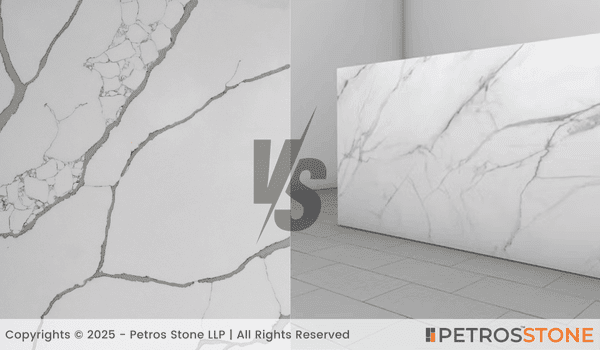
| Feature | Quartz | Sintered Stone |
| Composition | 90-95% quartz, resins | Natural minerals, no resins |
| Price | INR 240 to INR 550 per square foot for 2cm slabs and INR 350 to INR 650 per square foot for 3cm slabs | From INR 550 to INR 850, approximately |
| Durability | High, but can chip under force | Extremely high, resists cracks and chips |
| Heat Resistance | Sensitive to heat | Fully heat-resistant |
| Stain Resistance | Excellent (non-porous) | Excellent (non-porous) |
| Outdoor Use | Not suitable (UV fades) | Fully UV resistant |
| Porosity | Non-porous | Non-porous |
| Scratch Resistance | Good, but not scratch-proof | Excellent scratch resistance |
| Weight | Lighter, easier to install | Heavy needs professional installation |
| Customisation | Wide variety of colours/patterns | Limited patterns |
Composition Breakdown
- Quartz: Primarily crushed quartz crystals (90-95%) combined with polymer resins and pigments.
- Sintered Stone: A mix of natural minerals, including quartz, feldspar, silica, and clay, compressed and heated without binders.
Price Comparison
- Quartz: The typical price of quartz slabs in India ranges from INR 240 to INR 550 per square foot for 2cm slabs and INR 350 to INR 650 per square foot for 3cm slabs, making it a more budget-friendly option.
- Sintered Stone: Prices range from INR 550 to INR 850, reflecting its advanced durability and performance.
| Feature | Quartz | Sintered Stone |
| 2cm Slab Price | ₹240 – ₹550 per sq. ft. | ₹550 – ₹850 per sq. ft. |
| 3cm Slab Price | ₹350 – ₹650 per sq. ft. | ₹550 – ₹850 per sq. ft. |
| Installation Cost | Lower, due to lighter weight and easier handling | Higher, due to weight and specialised installation |
| Maintenance Cost | Minimal — no sealing required, just basic cleaning | Minimal — no sealing, highly stain-resistant, easy cleaning |
| Durability | Scratch and chip-resistant but sensitive to heat and UV | Extremely durable — heat, scratch, impact, and UV-resistant |
| Lifespan | 10-20 years with proper care | 20+ years — built to last, even in high-traffic areas and outdoors |
| Design Variety | Wide range of colours, patterns, and polished finishes | Natural stone, concrete, wood-like textures — realistic, modern look |
| Best for | Budget-conscious renovations, indoor kitchens, bathrooms, backsplashes | High-traffic kitchens, luxury spaces, outdoor areas, commercial use |
Cost vs. Long-Term Value
While quartz wins on upfront affordability, sintered stone delivers superior long-term value — especially for outdoor kitchens, luxury designs, and high-traffic homes or businesses.
Choose quartz if you aim for a low insvestment, stylish, and easy-to-maintain surface for indoor spaces.
Opt for sintered stone if you prioritise durability, heat resistance, and a luxury aesthetic that stands the test of time — indoors or outdoors.
Why Sintered Stone is Better than Quartz:
What makes sintered stone so remarkable? Let’s break down its standout features:
- Composed of Natural Minerals: Sintered stone is made purely from natural materials, without artificial binders or resins. This makes it an eco-friendly, sustainable choice.
- Mimics a Range of Aesthetics: Whether you love the timeless look of marble, the industrial feel of concrete, or the rustic charm of wood, sintered stone can replicate those textures and appearances with striking realism.
- Ultra-Compact, Non-Porous Structure: Thanks to the intense heat and pressure during manufacturing, sintered stone is densely packed and non-porous. This makes it highly resistant to stains, bacteria, and water damage — perfect for kitchens, bathrooms, and even outdoor spaces.
- Resistant to Extreme Temperatures: One of the most impressive qualities of sintered stone is its heat resistance. It can withstand high temperatures without scorching, cracking, or discolouration — you can place hot pots and pans directly on the surface without worry. It’s also frost-resistant, making it ideal for outdoor applications in colder climates.
- Scratch and Impact Resistant: Whether it’s a bustling kitchen or a busy commercial space, sintered stone holds up. It resists scratches, chips, and impacts, ensuring longevity even in high-traffic areas.
- UV Resistant: Unlike some materials that fade or yellow over time when exposed to sunlight, the sintered stone is UV-stable — meaning it maintains its colour and finish even in outdoor settings or sunlit rooms.
- Low Maintenance: Forget about sealing or special cleaners. Sintered stone is easy to clean with just soap and water, making it a hassle-free choice for busy households.
Pros and Cons of Quartz
Pros:
- Wide design options: Available in various colours, patterns, and finishes.
- Low maintenance: non-porous, so it doesn’t need sealing and resists stains.
- Durable: Resists scratches and chips in everyday use.
- Affordable: Cheaper than natural stone and sintered stone.
- Easy installation: Relatively lighter than sintered stone, making it easier to handle.
Cons:
- Heat sensitivity: Prolonged heat exposure can cause damage.
- Not suitable for outdoors: UV rays can cause discolouration.
- Visible seams: large countertops may have visible joints.
Pros and Cons of Sintered Stone
Pros:
- High durability: Extremely tough, resisting chips, scratches, and cracks.
- Heat resistant: Can withstand hot pans and direct sunlight without damage.
- UV resistant: Suitable for indoor and outdoor use.
- Stain resistant: non-porous, making it easy to clean.
- Eco-friendly: Made from natural materials without resin binders.
Cons:
- Higher cost: Starts from $250 per foot run — more expensive than quartz.
- Heavier: Requires professional installation due to weight.
- Limited design flexibility: Patterns may be less varied than quartz.
Standard Sizes for Quartz & Sintered Stone
- Quartz: Typically, available in slabs of 126×64 inches, with thicknesses ranging from 12mm to 30mm.
Check our this detailed article on standard sizes for more information:
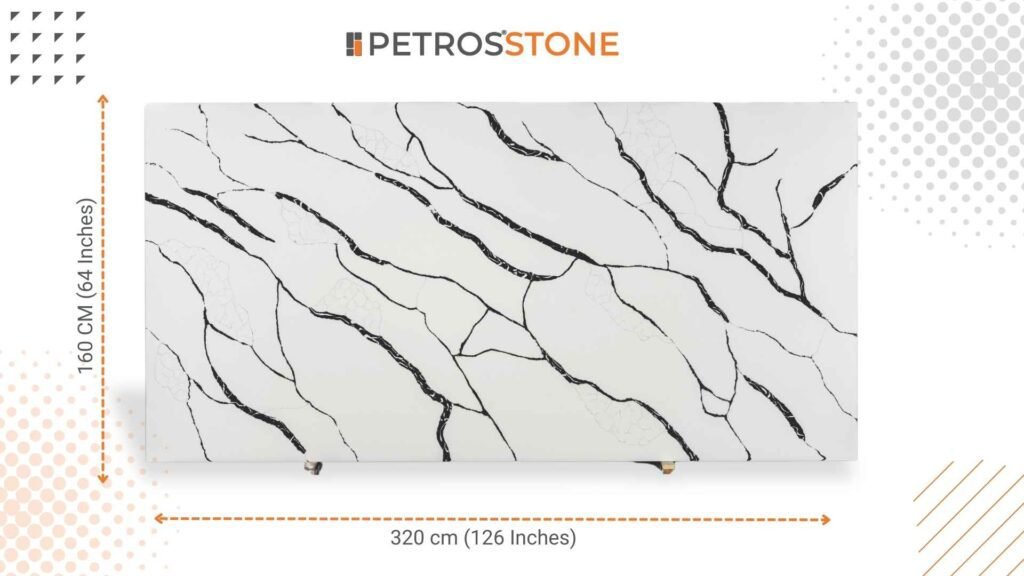
- Sintered Stone Standard Sizes: Larger slabs, typically 126×63 inches, with thicknesses between 6mm and 20mm.

Durability and Performance Factors
- Durability: Sintered stone wins with superior toughness, though quartz remains durable for everyday use.
- Stain Resistance: Both materials are non-porous and resist stains effectively.
- Heat Resistance: Sintered stone withstands high temperatures, while quartz may scorch.
- Outdoor Suitability: Sintered stone excels with UV resistance while quartz fades.
- Porosity: Both materials are non-porous, eliminating the need for sealing.
- Scratch Resistance: Sintered stone offers better scratch resistance.
- Chipping/Cracking: Quartz is more prone to chipping, while sintered stone resists cracks and chips better.
Choosing between quartz and sintered stone isn’t a one-size-fits-all decision — it’s all about your priorities, lifestyle, and budget. Let’s break it down:
Budget-Conscious Buyers
If you’re working with a tighter budget but still want a stylish, durable, and low-maintenance surface, quartz is a fantastic option. It offers a wide range of colours, patterns, and finishes — from marble-look designs to sleek, modern styles — at a more affordable price point than sintered stone or natural stone. Plus, its lighter weight makes installation more manageable and less expensive.
Best for: Renovations on a budget, trendy kitchens, bathrooms, and anyone looking for a balance of style and practicality without overspending.
Durability and Performance Seekers
For high-traffic areas, busy households, or even commercial kitchens, sintered stone is in a league of its own. Its ultra-compact, non-porous structure means it’s virtually indestructible — resisting scratches, stains, heat, and impacts.
If you frequently cook with high heat or need a surface that can handle hot pots and pans directly, sintered stone wins hands down. It’s also UV-resistant and frost-resistant, making it a perfect fit for outdoor kitchens, barbecues, and patios — places where quartz can fade or warp.
Best for: High-traffic kitchens, outdoor spaces, commercial use, and homes where performance and longevity matter more than the upfront cost.
Aesthetic and Design Flexibility
When it comes to customising your space, quartz and sintered stone, offer different types of design appeal:
- Quartz shines with bold colours, intricate patterns, and even glittering finishes. If you’re after a polished, modern look or want to replicate high-end materials (like marble or granite) for less, quartz offers endless design freedom.

- Sintered stone, on the other hand, delivers a sleek, minimalist, and natural aesthetic. It can mimic raw materials like concrete, wood, or natural stone with remarkable realism — perfect for those craving a sophisticated, organic vibe.
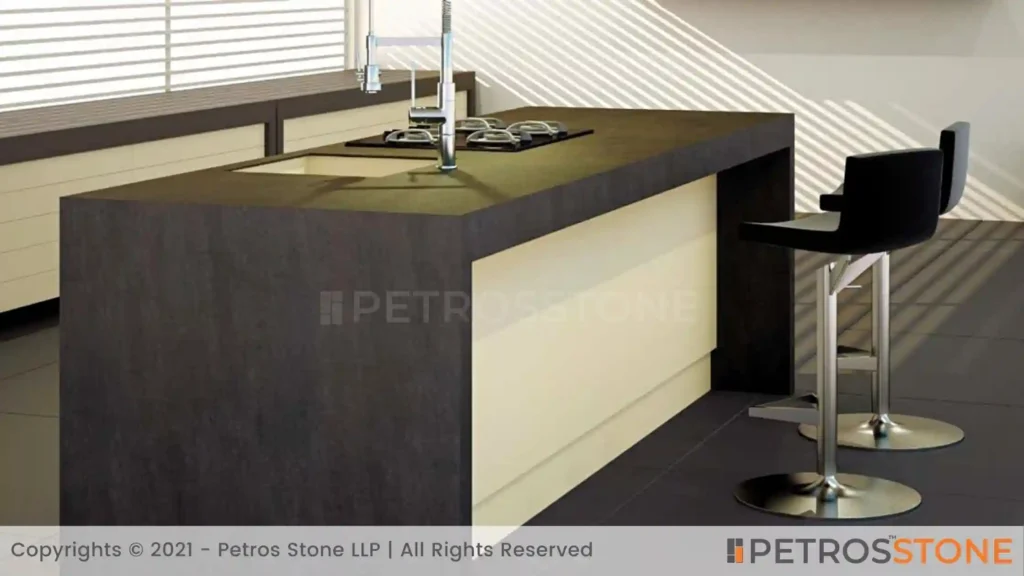
Best for: Trendsetters who want statement-making quartz countertops or design purists who prefer sintered stone’s realistic, earthy elegance.
Which is Right for You?
It boils down to this:
- Quartz = Affordable, stylish, and versatile for indoor use.
- Sintered Stone = Tough, heat/UV-resistant, and long-lasting — ideal for luxury kitchens, high-traffic zones, and outdoor spaces.
Why Quartz is better in some cases:
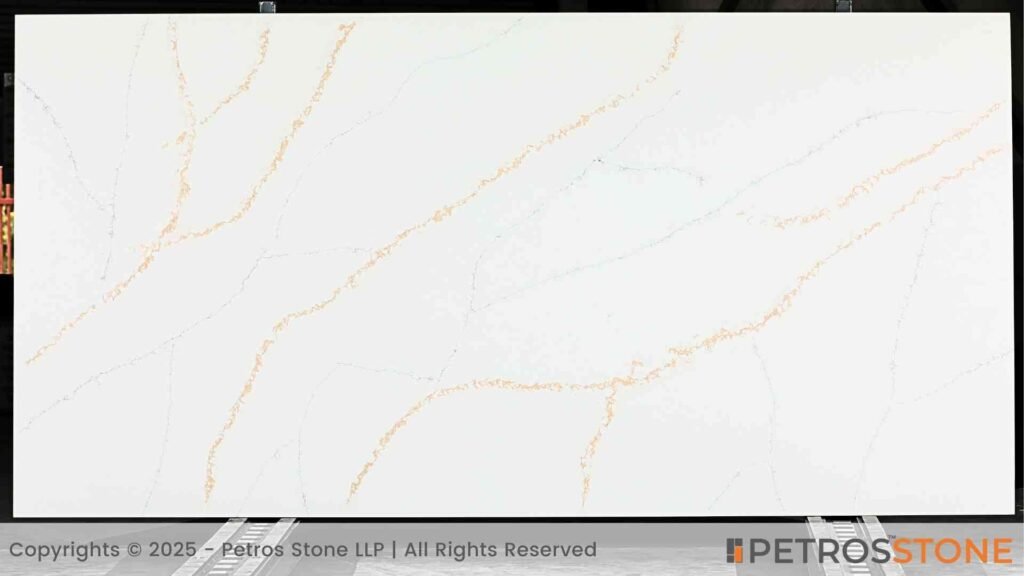
1. Made from Approximately 90-95% Natural Quartz
Quartz surfaces are engineered stone, composed primarily of crushed natural quartz crystals — one of the hardest minerals on Earth
Why it matters: This high quartz content ensures natural feel and finish. compared to artificial like sintered stone.
2. Wide Variety of Colors and Patterns
One of quartz’s biggest selling points is the vein flows through the edge – giving it a seamless look.
Why it matters: Seamless design.
3.Easier to Work with
Quartz being flexible in a way – is easier to work with – in terms of cutting, polishing and installing – it offers a level of comfort whcih can result in much better overall finish of the countertop/floor
Need more help?
Both quartz and sintered stone have impressive, high-quality surfaces, each excelling in different areas. Understanding their differences helps you choose the ideal material for your project, whether you value affordability and variety or toughness and longevity.
For more help get in touch with us here:
Feel free to get in touch for a free consultation, quote, and get a detailed understanding from our experts here at Petros®. Visit https://petrosstone.com/ or call +91-8446360361 and WhatsApp

Hi, I’m Khushbu,
With years of experience in the field of architecture, I’ve developed a deep appreciation for the impact of natural materials in design. At Petros® Stone, I write to share my perspective on how stone can modernize spaces with beauty, function, and timelessness.
Brown Granite
White Galaxy Granite
Blue Bahia Granite
Silver Cloud Granite
Black Pearl Granite
Dallas White Granite


